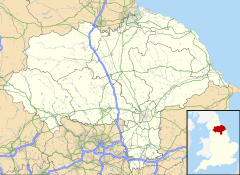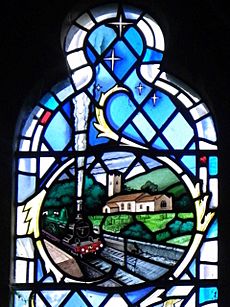Kildale facts for kids
Quick facts for kids Kildale |
|
|---|---|
 Looking down on Kildale from Park Nab, Christmas Day, 2007 |
|
| Population | 147 (2011 census) |
| OS grid reference | NZ6284209682 |
| Civil parish |
|
| Unitary authority |
|
| Ceremonial county | |
| Region | |
| Country | England |
| Sovereign state | United Kingdom |
| Post town | Whitby |
| Postcode district | YO21 |
| Police | North Yorkshire |
| Fire | North Yorkshire |
| Ambulance | Yorkshire |
| EU Parliament | Yorkshire and the Humber |
| UK Parliament |
|
Kildale is a small village and civil parish in North Yorkshire, England. It's about 3 miles (5 km) south-east of Great Ayton. The village is located inside the beautiful North York Moors National Park. It is also right on the Cleveland Way National Trail, a popular walking route.
Kildale is a small place. In 2011, only 147 people lived there. A church in Kildale was even mentioned in the old Domesday Book. Later, Viking items like bones and weapons were found where a church called St Cuthbert's was built. Kildale railway station is on the Esk Valley Line, making it easy to visit.
Contents
History of Kildale
Where Did the Name Kildale Come From?
The name Kildale comes from Norman times. Back then, it was written as "Childale." It's not clear exactly how "Chil" changed to "Kil." Some people think the name changed during Saxon times. This might be because of a Norse stream called Kyll. Or it could be named after a Saxon landowner.
For 900 years, Kildale's borders have stayed the same. Also, only three families have ever owned the area. First, the Percy family owned it. Around 1662, John Turner bought Kildale. After the last Turner died in 1806, Robert Bell Livesey bought it. His daughter married into the Turton family. The Turton family still owns Kildale today.
Ancient Stone Walls and the Kildale Estate
Many stone walls were built around Kildale's fields. These walls created boundaries for the land. Lots of them are still standing today, over 300 years later! Stone was used because it was easier to find than wood back then. Building these stone walls was very expensive and took a long time. Because of this, the estate still takes good care of them. They want to make sure the walls last forever. This helps keep Kildale's historic look.
Kildale is actually an estate. This means one family owns most of the farms and houses. The houses owned by the estate are only rented to people who live in the valley. This helps keep the community strong and friendly.
How Kildale's Population Has Changed
The number of people living in Kildale has changed a lot. This happened between 1880 and 1960. The highest number of people was in 1880. This might be because the mineral trade was growing in Kildale. The biggest change happened between 1881 and 1885. After the late 1800s, the population started to grow again. This was probably because medical care got better. More people lived longer, which helped the population grow.
Jobs in Kildale Over Time
In 1881, a census showed what jobs people had. Women in Kildale mostly worked in homes. They did things like cooking and sewing. Men mostly worked in farming. They also worked in the mines, digging for jet and iron ore.
By 2001, things had changed a lot. Most men and women worked in the service industry. This includes jobs in shops, transport, and food services. The 2011 Census showed even more changes. Education became the main job for women. Construction became the main job for men.
Comparing these times shows how jobs in Kildale have changed. People used to do more hands-on labor. Now, they work more in service jobs. This change is mostly because of new technology and modern ways of working. The mines are no longer open. Farming still happens, but fewer people work in it. Modern machines can do a lot of the work that many people used to do.
Important Places in Kildale
St Cuthbert's Church
The main church in Kildale is called St Cuthbert's. It was built in 1868. It replaced an older church that was built in Norman times. To get to the church, you cross an iron railway bridge. This bridge is near Kildale station.
The church has a beautiful stained-glass window. It was made around 1992–1996. The window shows scenes from Kildale. It even shows a steam train passing through the village. Inside the church, there is a list of names. It lists all the people who lived in Kildale for the millennium. It also lists many farmers who worked in Kildale from 1806 to 2006. This was when the Turton/Sutcliffe family owned the land.
When St Cuthbert's Church was being built, Viking items were found. This shows that the church area has been important for hundreds of years.
Captain Cook's Monument
Captain Cook's Monument was built in 1827. It remembers Captain James Cook, a famous explorer. He sailed all around the world. The monument is about one and a half miles from Kildale. It stands on a hill above where Captain Cook grew up on a farm.
Kildale Barn
Kildale Barn is an old building at Park Farm. It used to be a barn and a wheelhouse. In 1992, it was reopened as a camping barn. This happened with money from the Youth Hostel Association. It also got money from the Long Distance Walkers Association. The barn can sleep up to 18 people. Kildale Barn is located inside the North York Moors National Park.
Sports in Kildale
Kildale Cricket Club
Kildale Cricket Club started in 1902. The club's cricket ground is about a kilometer west of the village. It's located before you reach the River Leven. The club has two main teams. The Saturday 1st XI plays in the Langbaurgh Cricket League. The Midweek Senior XI plays in the Esk Valley Evening League.



